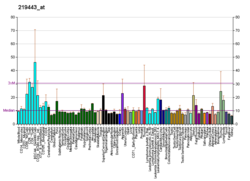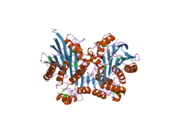Protein-coding gene in the species Homo sapiens
| TASP1 |
|---|
 |
| Available structures |
|---|
| PDB | Ortholog search: PDBe RCSB |
|---|
| List of PDB id codes |
|---|
2A8I, 2A8J, 2A8L, 2A8M |
|
|
| Identifiers |
|---|
| Aliases | TASP1, C20orf13, dJ585I14.2, taspase 1, SULEHS |
|---|
| External IDs | OMIM: 608270; MGI: 1923062; HomoloGene: 9795; GeneCards: TASP1; OMA:TASP1 - orthologs |
|---|
| Gene location (Human) |
|---|
 | | Chr. | Chromosome 20 (human)[1] |
|---|
| | Band | 20p12.1 | Start | 13,389,392 bp[1] |
|---|
| End | 13,638,932 bp[1] |
|---|
|
| Gene location (Mouse) |
|---|
 | | Chr. | Chromosome 2 (mouse)[2] |
|---|
| | Band | 2|2 F3 | Start | 139,675,400 bp[2] |
|---|
| End | 139,908,725 bp[2] |
|---|
|
| RNA expression pattern |
|---|
| Bgee | | Human | Mouse (ortholog) |
|---|
| Top expressed in | - popliteal artery
- Achilles tendon
- secondary oocyte
- tibia
- ascending aorta
- bronchial epithelial cell
- germinal epithelium
- hair follicle
- palpebral conjunctiva
- visceral pleura
|
| | Top expressed in | - spermatid
- Region I of hippocampus proper
- pineal gland
- barrel cortex
- spermatocyte
- lacrimal gland
- lens
- proximal tubule
- renal corpuscle
- nucleus accumbens
|
| | More reference expression data |
|
|---|
| BioGPS |  | | More reference expression data |
|
|---|
|
| Gene ontology |
|---|
| Molecular function | - peptidase activity
- hydrolase activity
- threonine-type endopeptidase activity
- identical protein binding
| | Cellular component | | | Biological process | - positive regulation of transcription, DNA-templated
- proteolysis
- protein maturation
| | Sources:Amigo / QuickGO |
|
| Orthologs |
|---|
| Species | Human | Mouse |
|---|
| Entrez | | |
|---|
| Ensembl | | |
|---|
| UniProt | | |
|---|
| RefSeq (mRNA) | |
|---|
NM_017714
NM_001323602
NM_001323603
NM_001323604 |
| |
|---|
NM_001159640
NM_001159641
NM_001289611
NM_175225 |
|
|---|
| RefSeq (protein) | |
|---|
NP_001310531
NP_001310532
NP_001310533
NP_060184 |
| |
|---|
NP_001153112
NP_001153113
NP_001276540
NP_780434 |
|
|---|
| Location (UCSC) | Chr 20: 13.39 – 13.64 Mb | Chr 2: 139.68 – 139.91 Mb |
|---|
| PubMed search | [3] | [4] |
|---|
|
| Wikidata |
| View/Edit Human | View/Edit Mouse |
|
Threonine aspartase 1 is an enzyme that in humans is encoded by the TASP1 gene.[5][6]
Function
This gene encodes an endopeptidase that cleaves specific substrates following aspartate residues. The encoded protein undergoes posttranslational autoproteolytic processing to generate alpha and beta subunits, which reassemble into the active alpha2-beta2 heterotetramer. It is required to cleave MLL, a protein required for the maintenance of HOX gene expression, and TFIIA, a basal transcription factor. Cleavage of TFIIA has been found to drive spermatogenesis.[7]
Alternatively spliced transcript variants have been described, but their biological validity has not been determined.[6]
Clinical significance
Taspase1 is overexpressed in primary human cancers and functions as a non-oncogene addiction protease that coordinates cancer cell proliferation and apoptosis. Therefore, Taspase1 may serve as a novel anti-cancer therapeutic target.[8]
References
- ^ a b c GRCh38: Ensembl release 89: ENSG00000089123 – Ensembl, May 2017
- ^ a b c GRCm38: Ensembl release 89: ENSMUSG00000039033 – Ensembl, May 2017
- ^ "Human PubMed Reference:". National Center for Biotechnology Information, U.S. National Library of Medicine.
- ^ "Mouse PubMed Reference:". National Center for Biotechnology Information, U.S. National Library of Medicine.
- ^ Hsieh JJ, Cheng EH, Korsmeyer SJ (Nov 2003). "Taspase1: a threonine aspartase required for cleavage of MLL and proper HOX gene expression". Cell. 115 (3): 293–303. doi:10.1016/S0092-8674(03)00816-X. PMID 14636557. S2CID 18952302.
- ^ a b "Entrez Gene: TASP1 taspase, threonine aspartase, 1".
- ^ Oyama, T; Sasagawa, S; Takeda, S; Hess, R. A.; Lieberman, P. M.; Cheng, E. H.; Hsieh, J. J. (2013). "Cleavage of TFIIA by Taspase1 activates TRF2-specified mammalian male germ cell programs". Developmental Cell. 27 (2): 188–200. doi:10.1016/j.devcel.2013.09.025. PMC 3947863. PMID 24176642.
- ^ Chen DY, Liu H, Takeda S, Tu HC, Sasagawa S, Van Tine BA, Lu D, Cheng EH, Hsieh JJ (July 2010). "Taspase1 functions as a non-oncogene addiction protease that coordinates cancer cell proliferation and apoptosis". Cancer Res. 70 (13): 5358–67. doi:10.1158/0008-5472.CAN-10-0027. PMC 2909739. PMID 20516119.
Further reading
- Zhou H, Spicuglia S, Hsieh JJ, et al. (2006). "Uncleaved TFIIA is a substrate for taspase 1 and active in transcription". Mol. Cell. Biol. 26 (7): 2728–35. doi:10.1128/MCB.26.7.2728-2735.2006. PMC 1430320. PMID 16537915.
- Khan JA, Dunn BM, Tong L (2006). "Crystal structure of human Taspase1, a crucial protease regulating the function of MLL". Structure. 13 (10): 1443–52. doi:10.1016/j.str.2005.07.006. PMID 16216576.
- Gerhard DS, Wagner L, Feingold EA, et al. (2004). "The status, quality, and expansion of the NIH full-length cDNA project: the Mammalian Gene Collection (MGC)". Genome Res. 14 (10B): 2121–7. doi:10.1101/gr.2596504. PMC 528928. PMID 15489334.
- Ota T, Suzuki Y, Nishikawa T, et al. (2004). "Complete sequencing and characterization of 21,243 full-length human cDNAs". Nat. Genet. 36 (1): 40–5. doi:10.1038/ng1285. PMID 14702039.
- Hsieh JJ, Ernst P, Erdjument-Bromage H, et al. (2003). "Proteolytic cleavage of MLL generates a complex of N- and C-terminal fragments that confers protein stability and subnuclear localization". Mol. Cell. Biol. 23 (1): 186–94. doi:10.1128/MCB.23.1.186-194.2003. PMC 140678. PMID 12482972.
- Strausberg RL, Feingold EA, Grouse LH, et al. (2003). "Generation and initial analysis of more than 15,000 full-length human and mouse cDNA sequences". Proc. Natl. Acad. Sci. U.S.A. 99 (26): 16899–903. Bibcode:2002PNAS...9916899M. doi:10.1073/pnas.242603899. PMC 139241. PMID 12477932.
- Deloukas P, Matthews LH, Ashurst J, et al. (2002). "The DNA sequence and comparative analysis of human chromosome 20". Nature. 414 (6866): 865–71. Bibcode:2001Natur.414..865D. doi:10.1038/414865a. PMID 11780052.
PDB gallery
-
2a8i: Crystal Structure of human Taspase1 -
2a8j: Crystal Structure of human Taspase1 (acivated form) -
2a8l: Crystal structure of Human Taspase1 (T234A mutant) -
2a8m: Crystal Structure of Human Taspase1 (T234S mutant) |
 | This article on a gene on human chromosome 20 is a stub. You can help Wikipedia by expanding it. |

 2a8i: Crystal Structure of human Taspase1
2a8i: Crystal Structure of human Taspase1 2a8j: Crystal Structure of human Taspase1 (acivated form)
2a8j: Crystal Structure of human Taspase1 (acivated form) 2a8l: Crystal structure of Human Taspase1 (T234A mutant)
2a8l: Crystal structure of Human Taspase1 (T234A mutant) 2a8m: Crystal Structure of Human Taspase1 (T234S mutant)
2a8m: Crystal Structure of Human Taspase1 (T234S mutant)























